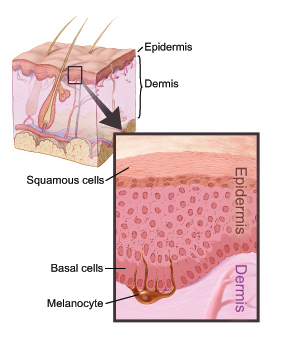|
The Skin
The skin is the body's largest
organ.
It protects against heat, light, injury,
and
infection.
It helps control body temperature. It stores water and fat. The
skin also makes vitamin D.
The skin has two main layers:
-
Epidermis:
The epidermis is the top layer of the skin. It is mostly made
of flat
cells.
These are
squamous cells.
Under the squamous cells in the
deepest part of the epidermis are round cells called
basal cells.
Cells called
melanocytes
make the pigment (color) found in skin and are located in the lower
part of the epidermis.
-
Dermis:
The dermis is under the epidermis. It contains blood vessels,
lymph
vessels, and
glands.
Some of these glands make sweat, which helps cool
the body. Other glands make
sebum.
Sebum is an oily substance that helps keep
the skin from drying out. Sweat and sebum reach the surface of the skin through
tiny openings called pores.

|
| This picture shows the layers of the skin. |
< Previous Section | Next Section > |